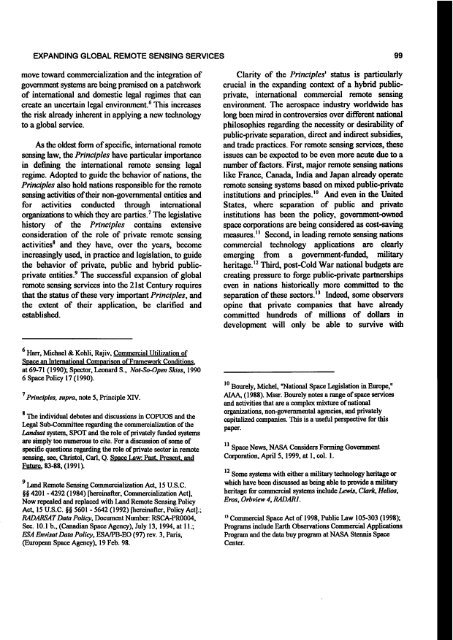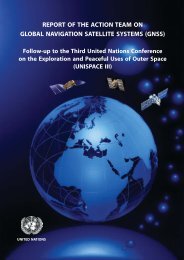Proceedings of the Workshop - United Nations Office for Outer ...
Proceedings of the Workshop - United Nations Office for Outer ...
Proceedings of the Workshop - United Nations Office for Outer ...
- No tags were found...
Create successful ePaper yourself
Turn your PDF publications into a flip-book with our unique Google optimized e-Paper software.
EXPANDING GLOBAL REMOTE SENSING SERVICES 99move toward commercialization and <strong>the</strong> integration <strong>of</strong>government systems are being premised on a patchwork<strong>of</strong> international and domestic legal regimes that cancreate an uncertain legal environment.6 This increases<strong>the</strong> risk already inherent in applying a new technologyto a global service.As <strong>the</strong> oldest <strong>for</strong>m <strong>of</strong> specific, international remotesensing law, <strong>the</strong> Principles have particular importancein defining <strong>the</strong> international remote sensing legalregime. Adopted to guide <strong>the</strong> behavior <strong>of</strong> nations, <strong>the</strong>Principles also hold nations responsible <strong>for</strong> <strong>the</strong> remotesensing activities <strong>of</strong> <strong>the</strong>ir non-governmental entities and<strong>for</strong> activities conducted through internationalorganizations to which <strong>the</strong>y are parties.7 The legislativehistory <strong>of</strong> <strong>the</strong> Principles contains extensiveconsideration <strong>of</strong> <strong>the</strong> role <strong>of</strong> private remote sensingactivities8 and <strong>the</strong>y have, over <strong>the</strong> years, becomeincreasingly used, in practice and legislation, to guide<strong>the</strong> behavior <strong>of</strong> private, public and hybrid publicprivateentities.9 The successful expansion <strong>of</strong> globalremote sensing services into <strong>the</strong> 21st Century requiresthat <strong>the</strong> status <strong>of</strong> <strong>the</strong>se very important Principles, and<strong>the</strong> extent <strong>of</strong> <strong>the</strong>ir application, be clarified andestablished.Clarity <strong>of</strong> <strong>the</strong> Principles' status is particularlycrucial in <strong>the</strong> expanding context <strong>of</strong> a hybrid publicprivate,international commercial remote sensingenvironment. The aerospace industry worldwide haslong been mired in controversies over different nationalphilosophies regarding <strong>the</strong> necessity or desirability <strong>of</strong>public-private separation, direct and indirect subsidies,and trade practices. For remote sensing services, <strong>the</strong>seissues can be expected to be even more acute due to anumber <strong>of</strong> factors. First, major remote sensing nationslike France, Canada, India and Japan already operateremote sensing systems based on mixed public-privateinstitutions and principles.10 And even in <strong>the</strong> <strong>United</strong>States, where separation <strong>of</strong> public and privateinstitutions has been <strong>the</strong> policy, government-ownedspace corporations are being considered as cost-savingmeasures.11 Second, in leading remote sensing nationscommercial technology applications are clearlyemerging from a government-funded, militaryheritage.12 Third, post-Cold War national budgets arecreating pressure to <strong>for</strong>ge public-private partnershipseven in nations historically more committed to <strong>the</strong>separation <strong>of</strong> <strong>the</strong>se sectors.13 Indeed, some observersopine that private companies that have alreadycommitted hundreds <strong>of</strong> millions <strong>of</strong> dollars indevelopment will only be able to survive with6Harr, Michael & Kohli, Rajiv, Commercial Utilization <strong>of</strong>Space an International Comparison <strong>of</strong> Framework Conditions.at 69-71 (1990); Spector, Leonard S., Not-So-Open Skies, 19906 Space Policy 17 (1990).7Principles, supra, note 5, Principle XIV.8 The individual debates and discussions in COPUOS and <strong>the</strong>Legal Sub-Committee regarding <strong>the</strong> commercialization <strong>of</strong> <strong>the</strong>Landsat system, SPOT and <strong>the</strong> role <strong>of</strong> privately funded systemsare simply too numerous to cite. For a discussion <strong>of</strong> some <strong>of</strong>specifi c questions regarding <strong>the</strong> role <strong>of</strong> private sector in remotesensing, see, Christol, Carl, Q. Space Law: Past. Present andFuture. 83-88, (1991)9 Land Remote Sensing Commercialization Act, 15 U.S.C.§§ 4201 - 4292 (1984) [hereinafter, Commercialization Act],Now repealed and replaced with Land Remote Sensing PolicyAct, 15 U.S.C. §§ 5601 - 5642 (1992) [hereinafter, Policy Act].;RADARSAT Data Policy , Document Number RSCA-PR0004,Sec. 10.1 b., (Canadian Space Agency), July 13, 1994, at 11.;ESA EnvisatData Policy, ESA/PB-EO (97) rev. 3, Paris,(European Space Agency), 19 Feb. 98.10 Bourely, Michel, "National Space Legislation in Europe,"AIAA, (1988). Mssr. Bourely notes a range <strong>of</strong> space servicesand activities that are a complex mixture <strong>of</strong> nationalorganizations, non-governmental agencies, and privatelycapitalized companies. This is a useful perspective <strong>for</strong> thispaper.11 Space News, NASA Considers Forming GovernmentCorporation, April 5, 1999, at 1, col. 1.12 Some systems with ei<strong>the</strong>r a military technology heritage orwhich have been discussed as being able to provide a militaryheritage <strong>for</strong> commercial systems include Lewis, Clark, Helios,Eros, Orbview 4, RADAR1.13 Commercial Space Act <strong>of</strong> 1998, Public Law 105-303 (1998);Programs include Earth Observations Commercial ApplicationsProgram and <strong>the</strong> data buy program at NASA Stennis SpaceCenter.
















